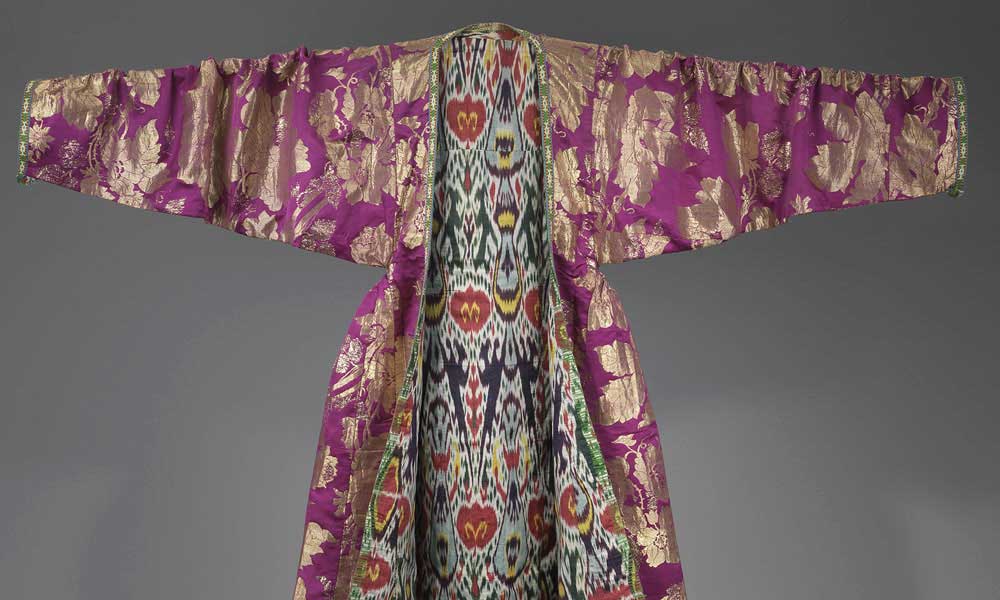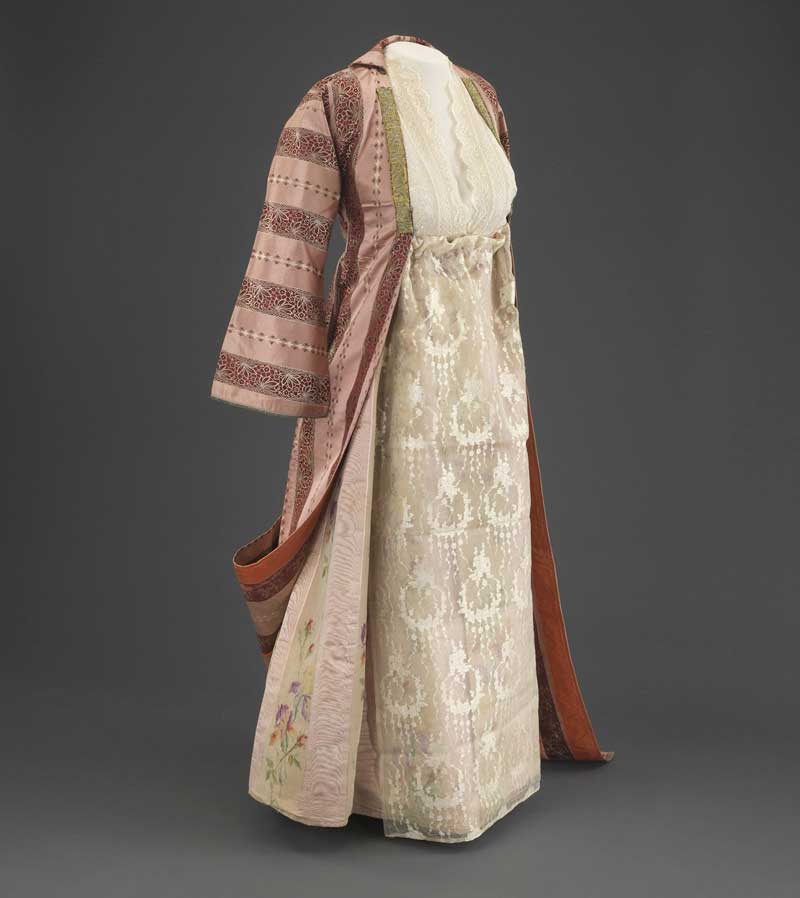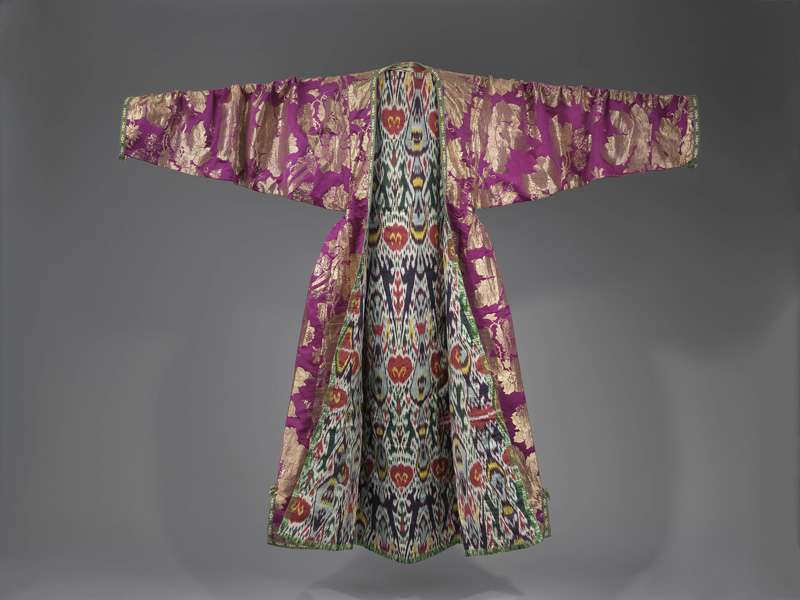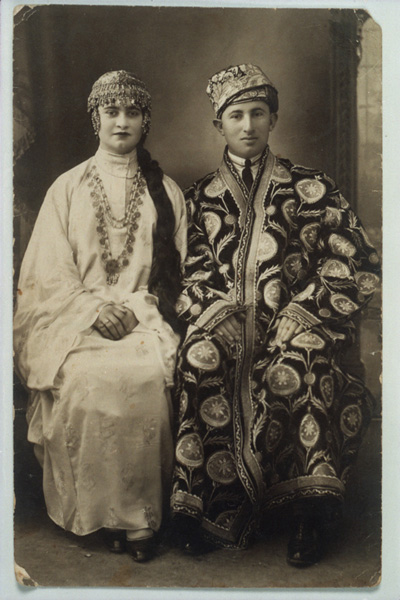Visual Moment | The Beguiling Language of Dress

Ribbed moiré silk from Greece, tulle and silver-tinsel embroidery from Egypt, silk satin from Ottoman Palestine, indigo-dyed goat hair from Iraqi Kurdistan, brocaded silk ikat from Uzbekistan. This intriguing and opulent array of historic garments and textiles is currently on display at the Contemporary Jewish Museum in San Francisco. The exhibition, Veiled Meanings: Fashioning Jewish Dress, from the Collection of The Israel Museum, Jerusalem, features some 100 items spanning the 18th to 20th centuries from four continents and more than 20 countries. On view through January 6, 2019, it is the first comprehensive U.S. exhibition drawn from The Israel Museum’s world-famous collection of Jewish costumes.
The garments displayed demonstrate the diversity of Jewish communities across centuries and continents and reflect the wide-ranging migrations of Jewish populations in Europe, Asia, North Africa and the Americas. The array is a testament to communities and forms of dress and craft that no longer exist. With its focus on function, color and artistry, the exhibit brings issues of migration and acculturation to life through the lens of fashion.

This early 20th-century married woman’s multilayered ensemble was from Salonika, in Ottoman Greece. Its silk coatdress, empire-waist sleeveless dress (entari), brocaded silk apron and lacy chest apron suggests that the outfit was meant to emphasize motherhood and nursing.
The show relates the story of how Jewish dress transmitted styles, motifs and dressmaking techniques from one community to another and how those traditions were in turn shaped by local customs and political and social changes in the areas where Jews settled. From Spain to Morocco, the Ottoman Empire to Algeria, and Baghdad to Calcutta, clothing styles developed from the interweaving of imported and local fashions, materials and craftsmanship, resulting in unique, often eclectic creations.
A woman’s ensemble from early 20th-century Algeria, for example, reflects the many changes that had an impact on the Jewish community there. The gilt embroidery on the front is borrowed from medieval Spanish costumes, likely brought to North Africa by Muslims and Jews fleeing the Christian Reconquista in the late Middle Ages. The floral pattern of the embroidery is typically Ottoman (the Empire ruled over Algeria for three centuries), and the sleeveless cut is similar to that of the entari dress worn by Jewish women during the same time period in Salonika in northern Greece.
From cultural dress codes to individual forms of self-expression, the exhibit looks at how clothing balances the personal and social and how it distinguishes different communities. Clothes worn by Jews were often similar or even identical to those worn by their non-Jewish neighbors, but special features sometimes set them apart. Veils and wraps were worn by Jewish women in Afghanistan, Iraq and Uzbekistan, reflecting the influence of local Islamic culture. The Herati chador, however, a wrap that originated in Muslim Iran and was brought to Afghanistan by Mashhadi crypto-Jews who fled to Herat because of persecution at the beginning of the 19th century, was unique to Jews. In Herat it differentiated Jewish women from the Muslim women who wore the burka.

The vibrant colors and rich materials (Russian brocaded silk and an ikat-dyed silk and cotton lining) of this luxurious, late 19th-century collarless woman’s coat, or kaltachak, from Bukhara, Uzbekistan, indicate that it once belonged to a wealthy woman.
The clothes we wear become a part of us. They embody our histories, our environments, our dreams, memories and aspirations. But to what degree, the exhibition asks, is one’s choice of clothing discretionary? And to what extent is it determined or restricted by those very concerns?
Clothing conceals and reveals, literally and figuratively. It covers our bodies, but it can also uncover hidden histories and personal narratives. The extent to which women’s bodies are revealed or concealed by their clothing continues to be an issue today. Encoded messages, clandestine meanings and traditional motifs are often embedded in clothing. These symbols convey information about gender, age, geography, background, status and custom. Before the advent of modern medicine, amulets and symbols were often used as protection. Cowry shells, red stitching and asymmetry, for instance, were believed to have mystical powers. Spiral-patterned embroidery symbolized the cycle of life. In North African communities, wearing black was associated with the destruction of the Temple in Jerusalem.
Amulets related to Jewish tradition date back to ancient times and appear in the Babylonian Talmud and in the Kabbalistic tradition. The earliest amulets were often made of semi-precious or precious stones. One of the most common amuletic symbols is the hamsa. A North African emblem used in both Judaism and Islam to ward off evil, it’s frequently depicted as a hand or an open palm, sometimes with an eye at its center.

David and Rina Davidoff donned traditional Bukharan attire for their betrothal in Jerusalem in 1927.
Fine craftsmanship and colorful designs reference the historic role the Jewish people played in textile production. In places such as Bukhara, Uzbekistan, indigo and ikat dye techniques were often considered too lowly or dirty (they were prone to leave lasting stains on the hands of the dyer) for Muslims to engage in, thus enabling Jewish craftspeople to monopolize those key trades.
Garments frequently were altered and repurposed over time. An elaborate bridal gown would have accompanied an aristocratic Ottoman Jewish woman throughout her life and often was worn at festive occasions after the wedding. Following her death, it likely would have been refashioned as a Torah ark curtain. In Afghanistan, it was customary for Jewish women to donate their scarves to be tied to the finials of the synagogue’s Torah scroll for decoration and to perpetuate their memory.
Each item in this engaging exhibition tells a story—the story of its creator or wearer, of the community to which it belonged, its position in time and space, and its journey through generations, families, networks of travel and rites of passage. It’s a story worth experiencing.—Diane M. Bolz
